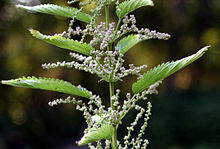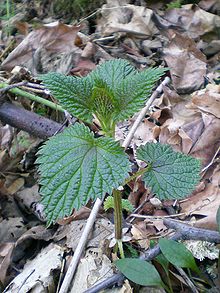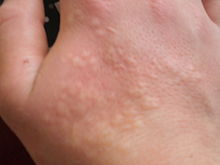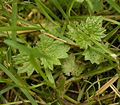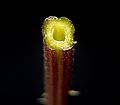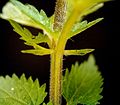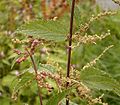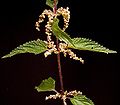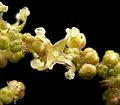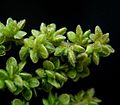- Stinging nettle
-
Stinging nettle Urtica dioica subsp. dioica Scientific classification Kingdom: Plantae Division: Magnoliophyta Class: Magnoliopsida Order: Rosales Family: Urticaceae Genus: Urtica Species: U. dioica Binomial name Urtica dioica
L.Stinging nettle or common nettle, Urtica dioica, is a herbaceous perennial flowering plant, native to Europe, Asia, northern Africa, and North America, and is the best-known member of the nettle genus Urtica. The plant has many hollow stinging hairs called trichomes on its leaves and stems, which act like hypodermic needles that inject histamine and other chemicals that produce a stinging sensation when contacted by humans and other animals.[1] The plant has a long history of use as a medicine and as a food source.
Contents
Description
Stinging nettle is a dioecious herbaceous perennial, 1 to 2 m (3 to 7 ft) tall in the summer and dying down to the ground in winter. It has widely spreading rhizomes and stolons, which are bright yellow as are the roots. The soft green leaves are 3 to 15 cm (1 to 6 in) long and are borne oppositely on an erect wiry green stem. The leaves have a strongly serrated margin, a cordate base and an acuminate tip with a terminal leaf tooth longer than adjacent laterals. It bears small greenish or brownish numerous flowers in dense axillary inflorescences. The leaves and stems are very hairy with non-stinging hairs and also bear many stinging hairs (trichomes), whose tips come off when touched, transforming the hair into a needle that will inject several chemicals: acetylcholine, histamine, 5-HT (serotonin), moroidin[2], leukotrienes[2], and possibly formic acid.[3][4] This mixture of chemical compounds cause a painful sting or paresthesia from which the species derives its common name, as well as the colloquial names burn nettle, burn weed, burn hazel.
Taxonomy
The taxonomy of stinging nettles has been confused, and older sources are likely to use a variety of systematic names for these plants. Formerly, more species were recognised than are now accepted. However, there are at least five clear subspecies, some formerly classified as separate species:
- U. dioica subsp. dioica (European stinging nettle). Europe, Asia, northern Africa.
- U. dioica subsp. galeopsifolia (fen nettle or stingless nettle). Europe. (Sometimes known as Urtica galeopsifolia)
- U. dioica subsp. afghanica. Southwestern and central Asia. (Gazaneh in Iran)
- U. dioica subsp. gansuensis. Eastern Asia (China).
- U. dioica subsp. gracilis (Ait.) Selander (American stinging nettle). North America.
- U. dioica subsp. holosericea (Nutt.) Thorne (hairy nettle). North America.
Other species names formerly accepted as distinct by some authors but now regarded as synonyms of U. dioica include U. breweri, U. californica, U. cardiophylla, U. lyalli, U. major, U. procera, U. serra, U. strigosissima, U. trachycarpa, and U. viridis. Other vernacular names include tall nettle, slender nettle, California nettle, jaggy nettle, burning weed, fire weed and bull nettle (a name shared by Cnidoscolus texanus and Solanum carolinense).
Distribution
Stinging nettles are abundant in northern Europe and much of Asia, usually found in the countryside. It is less gregarious in southern Europe and north Africa, where it is restricted by its need for moist soil. In North America it is widely distributed in Canada and the United States, where it is found in every province and state except for Hawaii and also can be found in northernmost Mexico. It grows in abundance in the Pacific Northwest, especially in places where annual rainfall is high. In North America the stinging nettle is far less common than in northern Europe. The European subspecies has been introduced into North America as well as South America.
In the UK stinging nettles have a strong association with human habitation and buildings. The presence of nettles may indicate that a building has been long abandoned. Human and animal waste may be responsible for elevated levels of phosphate and nitrogen in the soil, providing an ideal environment for stinging nettles.
Ecology
The Nettle Pouch Gall Dasineura urticae on Urtica dioica
Nettles are the exclusive larval food plant for several species of butterfly, such as the Peacock Butterfly[5] or the Small Tortoiseshell, and are also eaten by the larvae of some moths including Angle Shades, Buff Ermine, Dot Moth, The Flame, The Gothic, Grey Chi, Grey Pug, Lesser Broad-bordered Yellow Underwing, Mouse Moth, Setaceous Hebrew Character and Small Angle Shades. The roots are sometimes eaten by the larva of the Ghost Moth Hepialus humuli.
Medicinal uses
As Old English Stiðe, nettle is one of the nine plants invoked in the pagan Anglo-Saxon Nine Herbs Charm, recorded in the 10th century. Nettle is believed to be a galactagogue.[6]
Urtication, or flogging with nettles, is the process of deliberately applying stinging nettles to the skin in order to provoke inflammation. An agent thus used is known as a rubefacient (something that causes redness). This is done as a folk remedy for rheumatism, providing temporary relief from pain.[citation needed] The counter-irritant action to which this is often attributed can be preserved by the preparation of an alcoholic tincture which can be applied as part of a topical preparation, but not as an infusion, which drastically reduces the irritant action.
Nettle leaf is a herb that has a long tradition of use as an adjuvant remedy in the treatment of arthritis in Germany. Nettle leaf extract contains active compounds that reduce TNF-α and other inflammatory cytokines.[7][8] It has been demonstrated that nettle leaf lowers TNF-α levels by potently inhibiting the genetic transcription factor that activates TNF-α and IL-1B in the synovial tissue that lines the joint.[9]
Nettle is used in shampoo to control dandruff and is said to make hair more glossy, which is why some farmers include a handful of nettles with cattle feed.[10]
Nettle root extracts have been extensively studied in human clinical trials as a treatment for symptoms of benign prostatic hyperplasia (BPH). These extracts have been shown to help relieve symptoms compared to placebo both by themselves [11] and when combined with other herbal medicines.[12]
Because it contains 3,4-divanillyltetrahydrofuran, certain extracts of the nettle are used by bodybuilders in an effort to increase free testosterone by occupying sex-hormone binding globulin[13]
Food
Stinging nettle has a flavour similar to spinach when cooked and is rich in vitamins A, C, iron, potassium, manganese, and calcium. Young plants were harvested by Native Americans and used as a cooked plant in spring when other food plants were scarce.[14] Soaking nettles in water or cooking will remove the stinging chemicals from the plant, which allows them to be handled and eaten without incidence of stinging. After Stinging Nettle enters its flowering and seed setting stages the leaves develop gritty particles called "cystoliths", which can irritate the urinary tract.[14] In its peak season, stinging nettle contains up to 25% protein, dry weight, which is high for a leafy green vegetable.[15] The young leaves are edible and make a very good pot-herb. The leaves are also dried and may then be used to make a tisane, as can also be done with the nettle's flowers.
Nettles can be used in a variety of recipes, such as polenta, pesto and purée[16]. Nettle soup is a common use of the plant, particularly in Northern and Eastern Europe. In Nepal and the Kumaon region of Northern India, Stinging Nettle is known as Shishnu. It is a very popular vegetable and cooked with Indian spices.
Nettles are sometimes used in cheese making, for example in the production of Yarg[17] and as a flavouring in varieties of Gouda.[18]
Competitive eating
In the UK, an annual Stinging Nettle Eating Championship draws thousands of people to Dorset, where competitors attempt to eat as much of the raw plant as possible. Competitors are given 60 cm (20 in) stalks of the plant, from which they strip the leaves and eat them. Whoever strips and eats the most stinging nettle leaves in a fixed time is the winner. The competition dates back to 1986, when two neighbouring farmers attempted to settle a dispute about which had the worst infestation of nettles.[19][20]
Drink
Nettle leaves are steeped in a concentrated sugar solution so the flavour is extracted into the sugar solution. The leaves are then removed and a source of citric acid (usually lemon juice) is added to help preserve the cordial and add a tart flavour.
Commercially produced cordials are generally quite concentrated and are usually diluted by one part cordial to ten parts water – thus a 0.5 litres (0.11 imp gal; 0.13 US gal) bottle of cordial would be enough for 5.5 litres (1.2 imp gal; 1.5 US gal) diluted. The high concentration of sugar in nettle cordial gives it a long shelf life.
There are also many recipes for alcoholic nettle beer, which is a countryside favourite in the British Isles.[21]
Nettle sting treatment
Anti-itch drugs, usually in the form of creams containing antihistaminics or hydrocortisone[citation needed] may provide relief from the symptoms of being stung by nettles. But due to the combination of chemicals involved other remedies may be required. Calamine lotion may be helpful. Many folk remedies exist for treating the itching including horsetail (Equisetopsida spp.), leaf of dock (Rumex spp.), Jewelweed, (Impatiens capensis and Impatiens pallida), the underside of a fern (the spores), mud, saliva, or baking soda, oil and onions, and topical use of milk of magnesia. Lemon juice also works for treatment.
Influence on language and culture
In Great Britain the stinging nettle is the only common stinging plant and has found a place in several figures of speech in the English language. Shakespeare's Hotspur urges that "out of this nettle, danger, we pluck this flower, safety" (Henry IV, part 1, Act II Scene 3). The figure of speech "to grasp the nettle" probably originated from Aesop's fable "The Boy and the Nettle".[22] In Sean O'Casey's Juno and the Paycock one of the characters quotes Aesop "Gently touch a nettle and it'll sting you for your pains/Grasp it as a lad of mettle and soft as silk remains". The metaphor may refer to the fact that if a nettle plant is grasped firmly rather than brushed against, it does not sting so readily, because the hairs are crushed down flat and do not penetrate the skin so easily.[23] In the German language, the idiom "sich in die Nesseln setzen", or to sit in nettles, means to get into trouble.
Textiles
Nettle stems contain a bast fibre that has been traditionally used for the same purposes as linen and is produced by a similar retting process. Unlike cotton, nettles grow easily without pesticides. The fibres are coarser however.[24]
In recent years a German company has started to produce commercial nettle textiles.
Nettles may be used as a dye-stuff, producing yellow from the roots, or yellowish green from the leaves.[25]
Gardening
As well as the potential for encouraging beneficial insects, nettles have a number of other uses in the vegetable garden.
The growth of stinging nettle is an indicator that an area has high fertility (especially phosphorus) and has been disturbed.[26][27]
Nettles contain a lot of nitrogen and so are used as a compost activator[28] or can be used to make a liquid fertiliser which although somewhat low in phosphate is useful in supplying magnesium, sulphur and iron.[29][30] They are also one of the few plants that can tolerate, and flourish in, soils rich in poultry droppings.
Recent experiments have shown that nettles may have some use as a companion plant.[31]
Stinging nettle can be a troubling weed, and mowing can increase plant density.[32] Regular and persistent tilling will greatly reduce its numbers, the use of herbicides such as 2,4-D and Glyphosate, are effective control measures.[32]
Gallery
-
The nettle can be used as a foodstuff, as the purée shown in the above image.
See also
Notes
- ^ Per Brodal (2010). The Central Nervous System: Structure and Function. Oxford University Press US. pp. 170–. ISBN 9780195381153. http://books.google.com/books?id=iJjI6yDNmr8C&pg=PA170. Retrieved 22 September 2010.
- ^ a b [1]
- ^ Louis J. Casarett; Curtis D. Klaassen; John Doull (2008). Casarett and Doull's toxicology: the basic science of poisons. McGraw-Hill Professional. pp. 1104–. ISBN 9780071470513. http://books.google.com/books?id=4yi7-j48uhIC&pg=PA1104. Retrieved 22 September 2010.
- ^ Michael I. Greenberg (4 June 2003). Occupational, industrial, and environmental toxicology. Elsevier Health Sciences. pp. 180–. ISBN 9780323013406. http://books.google.com/books?id=NnZ23IqU4SoC&pg=PA180. Retrieved 22 September 2010.
- ^ Heiko Bellmann: Der Neue Kosmos Schmetterlingsführer, Schmetterlinge, Raupen und Futterpflanzen, pg. 170, Frankh-Kosmos Verlags-GmbH & Co, Stuttgart 2003, ISBN 3-440-09330-1
- ^ Westfall R.E., Galactagogue herbs: a qualitative study and review. Canadian Journal of Midwifery Research and Practice. 2(2):22–27. (2003)
- ^ Teucher T, et al. Cytokine secretion in whole blood of healthy subjects following oral administration of Urtica dioica L. plant extract. Arzneimittelforschung 1996 Sep;46(9):906–10.
- ^ Obertreis B, et al. Ex-vivo in-vitro inhibition of lipopolysaccharide stimulated tumor necrosis factor-alpha and interleukin-1 beta secretion in human whole blood by extractum urticae dioicae foliorum. Arzneimittelforschung 1996 Apr;46(4):389–94. Published erratum appears in Arzneimittelforschung 1996 Sep;46(9):936.
- ^ Riehemann K, et al. Plant extracts from stinging nettle (Urtica dioica), an antirheumatic remedy, inhibit the proinflammatory transcription factor NF-kappaB. FEBS Lett 1999 Jan 8;442(1):89–94.
- ^ Balch, Phyllis A., CNC, Balch, James F., M.D., Prescription for Nutritional Healing, Avery Press, p. 104 (2000) (ISBN 1-58333-077-1)
- ^ Safarinejad MR. Urtica dioica for treatment of benign prostatic hyperplasia: a prospective, randomized, double-blind, placebo-controlled, crossover study. J Herb Pharmacother.. 2005;5(4):1-11.
- ^ Lopatkin N, Sivkov A, Walther C, Schlafke S, Medvedev A, Avdeichuk J, Golubev G, Melnik K, Elenberger N, Engelmann U. Long-term efficacy and safety of a combination of sabal and urtica extract for lower urinary tract symptoms: a placebo-controlled, double-blind, multi-center trial. World Journal of Urology. 2005 June 1
- ^ Schöttner M, Gansser D, Spiteller G. Interaction of lignans with human sex hormone binding globulin (SHBG). " Z Naturforsch [C]". 1997 Nov–Dec;52(11–12):834–43.
- ^ a b Gregory L. Tilford, Edible and Medicinal Plants of the West, ISBN 0-87842-359-1
- ^ Hughes (2006), "The dietary potential of the common nettle", Journal of the Science of Food and Agriculture, 31:12 p 1279
- ^ http://www.wattpad.com/399865-1069-recetas-de-cocina-karlos-argui%C3%B1ano?p=71 Recetas de cocina 423
- ^ "Lynher Dairies Nettles & Garlic". Lynherdairies.co.uk. http://www.lynherdairies.co.uk/nettles-and-garlic.html. Retrieved 2010-07-05.
- ^ "Gouda Cheese with Stinging Nettles: Cooking Terms". RecipeTips.com. http://www.recipetips.com/glossary-term/t--38676/gouda-cheese-with-stinging-nettles.asp. Retrieved 2010-07-05.
- ^ BBC Dorset report on world nettle eating championships
- ^ Daily Telegraph item about world nettle eating championships.
- ^ "Two more nettle beer recipes including a stronger nettle beer". Selfsufficientish.com. http://www.selfsufficientish.com/strongernettlebeer.htm. Retrieved 2010-07-05.
- ^ "The Project Gutenberg eBook of The Æsop For Children, by Æsop". Gutenberg.org. 2006-12-02. http://www.gutenberg.org/files/19994/19994-h/19994-h.htm#Page_88. Retrieved 2010-07-05.
- ^ Grasping the nettle: an empirical enquiry, 2010-09-05, http://doug.dreamwidth.org/206733.html, retrieved 2010-09-06
- ^ "Student shows off nettle knickers". BBC News. July 1, 2004. http://news.bbc.co.uk/2/low/uk_news/england/leicestershire/3857445.stm. Retrieved May 24, 2010.
- ^ Piers Warren, 101 uses for Stinging Nettles (2006), p 65, ISBN 095418999X. Google Books
- ^ "Indicator Weeds and Soil Conditions at". Garden-helper.com. http://www.garden-helper.com/Learn/Charts_And_Tables/indicator-weeds-soil-conditions.asp. Retrieved 2010-07-05.
- ^ "virtual-herb-walk". Herbalpractitioner.com. http://www.herbalpractitioner.com/virtual-herb-walk.html. Retrieved 2010-07-05.
- ^ "h2g2 - Stinging Nettles". BBC DNA. http://www.bbc.co.uk/dna/h2g2/A1310950. Retrieved 2010-07-05.
- ^ Pears, Pauline, et al. HDRA Encyclopedia Of Organic Gardening, pp207, Dorling Kindersley Ltd, London, 2005.
- ^ "Compost Teas vs Other Teas and Extracts". Ciwmb.ca.gov. http://www.ciwmb.ca.gov/organics/compostmulch/composttea/OtherTeas.htm. Retrieved 2010-07-05.
- ^ "2009 | Plants | GardenWise". Gardenwiseonline.ca. http://www.gardenwiseonline.ca/gw/plants/2009/05/08/stinging-nettle-history-and-uses. Retrieved 2010-07-05.
- ^ a b Wood Powell Anderson (1999). Perennial weeds: characteristics and identification of selected herbaceous species. Wiley-Blackwell. pp. 25–. ISBN 9780813825205. http://books.google.com/books?id=5qGQsJl1v60C&pg=PA25. Retrieved 17 October 2010.
References
- Elliott, C. (1997). Rash Encounters. Horticulture 94: 30.
- Schofield, Janice J. (1998). Nettles ISBN 0-585-10500-6
- Thiselton-Dyer, T. F., (1889). The Folk-Lore of Plants.
- Glawe, G. A. (2006). Sex ratio variation and sex determination in Urtica diocia. ISBN 90-6464-026-2
External links
- Profile: Stinging Nettle (Urtica dioica) Photos, Drawings, Text. (Wild Plants of Winnipeg from Nature Manitoba)
- Germplasm Resources Information Network: Urtica dioica
- Flora of China: Urtica dioica
- Russian Stinging Nettle Soup Recipe
- Stinging Nettle Recipes
Categories:- Urticaceae
- Fiber plants
- Leaf vegetables
- Flora of Europe
- Flora of Estonia
- Flora of the United Kingdom
- Flora of Michigan
- Medicinal plants
- Poisonous plants
Wikimedia Foundation. 2010.




